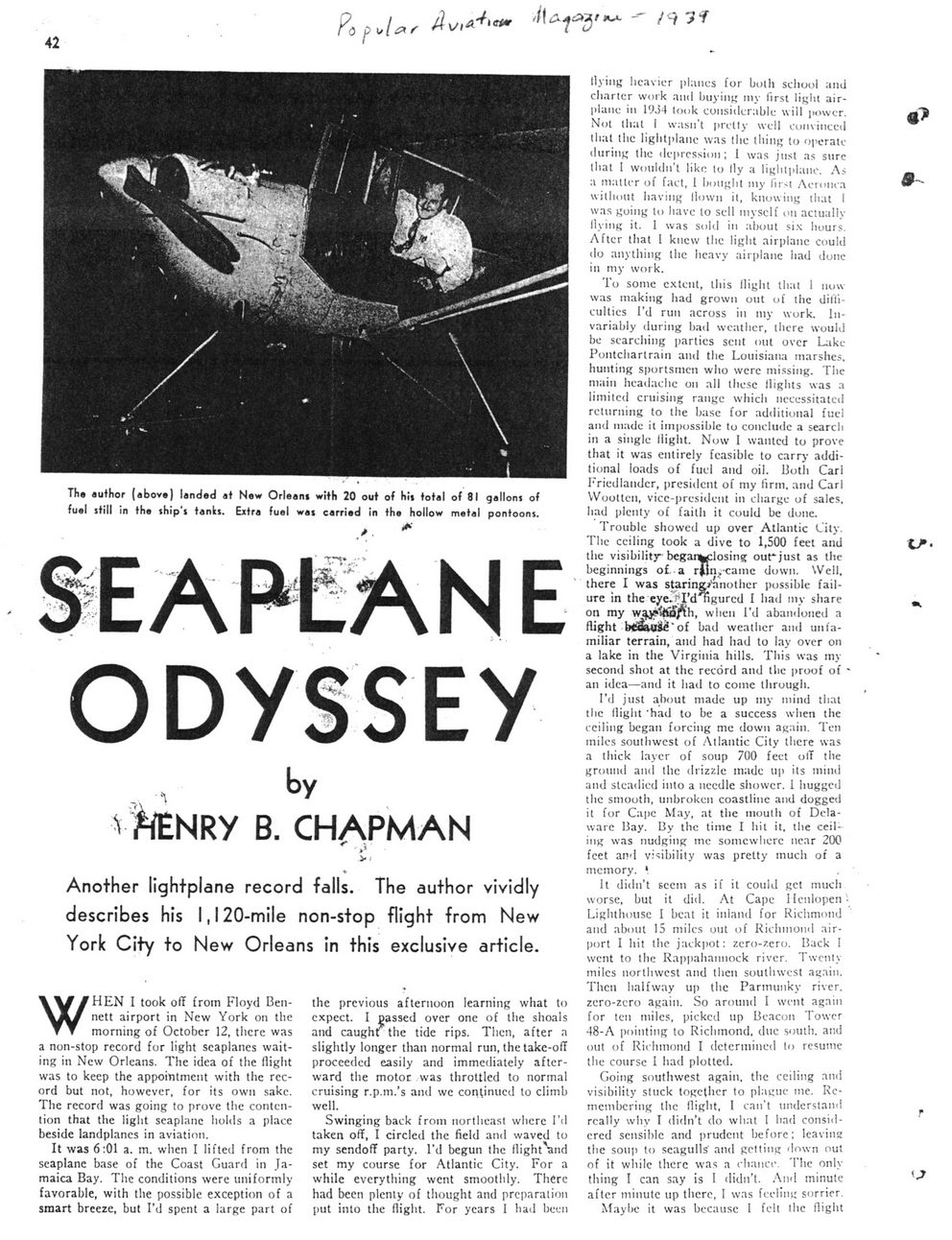This text was obtained via automated optical character recognition.
It has not been edited and may therefore contain several errors.
42
atnr
4\.
The author (above) landed at New Orleans with 20 out of hi* total of 81 gallons of fuel still in the ship?s tanks. Extra fuel was carried in the hollow metal pontoons.
by
vftENRY B. CHAPMAN
* /*
>)
Another lightplane record falls. The author vividly describes his 1,120-mile non-stop flight from New York City to New Orleans in this exclusive article.
WHEN I took off from Floyd Bennett airport in New York on the morning of October 12, there was a non-stop record for light seaplanes waiting in New Orleans. The idea of the flight was to keep the appointment with the record but not, however, for its own sake. The record was going to prove the contention that the light seaplane holds a place beside landplancs in aviation.
It was 6:01 a. m. when I lifted from the seaplane base of the Coast Guard in Jamaica Bay. The conditions were uniformly favorable, with the possible exception of a smart breeze, but I?d spent a large part of
the previous afternoon learning what to expect. I passed over one of the shoals and caught the tide rips. Then, after a slightly longer than normal run, the take-off proceeded easily and immediately afterward the motor was throttled to normal cruising r.p.m.?s and we continued to climb well.
Swinging back from northeast where I'd taken off, I circled the field and waved to my sendofif party. I'd begun the flight\nd set my course for Atlantic City. For a while everything went smoothly. There had been plenty of thought and preparation put into the flight. For years I had been
flying heavier planes for both school and charter work and buying my first light airplane in 19.i4 look considerable will power. Not that I wasn't pretty well convinced that the liglitplanc was the tiling to operate during the depression; I was just as sure that I wouldn't like lo lly a lighlplane. As a matter of fact, 1 bought my first Aeroma without having llown il, knowing that I was going to have to sell myself on actually living it. I was sold in about six hours. After that 1 knew the light airplane could do anything the heavy airplane had done in my work.
To some extent, this flight that 1 now was making had grown out of the difficulties I?d run across in my work. Invariably during had weather, there would be searching parties sent out over Lake Pontchartrain and the Louisiana marshes, hunting sportsmen who were missing. The main headache on all these flights was a limited cruising range which necessitated returning to the base for additional fuel and made it impossible to conclude a search in a single flight. Now I wanted to prove that it was entirely feasible to carry additional loads of fuel and oil. Both Carl Friedlandcr, president of my firm, and Carl Wootten, vice-president in charge of sales, had plenty of faith it could be done.
Trouble showed up over Atlantic City. The ceiling took a dive to 1,500 feet and the visibility beganhclosing out*just as the beginnings o? a r{|n,came down. Well, there I was staringj'another possible failure in the eyeJifl?d ngurcd I had my share on my when I?d abandoned a
flight b<SJauW' of bad weather and unfamiliar terrain, and had had to lay over on a lake in the Virginia hills. This was my second shot at the record and the proof of -an idea?and it had to come through.
I?d just about made up my mind that the flight had to be a success when the ceiling began forcing me down again. Ten miles southwest of Atlantic City there was a thick layer of soup 700 feet oil the ground and the drizzle made up its mind and steadied into a needle shower. I hugged the smooth, unbroken coastline and dogged it for Cape May, at the moulh of Delaware Bay. By the time I hit it, the ceiling was nudging me somewhere near 200 feet and visibility was pretty much of a memory. ?
It didn?t seem as if it could get much worse, but it did. At Cape Henlopen ? Lighthouse I beat it inland for Richmond and about 15 miles out of Richmond airport I hit the jackpot: zero-zero. Back I went to the Rappahannock river. Twenty miles northwest and then southwest again. Then halfway up the Parmunky river, zero-zcro again. So around I went again for ten miles, picked up Beacon Tower 48-A pointing to Richmond, due south, and out of Richmond I determined to resume the course I had plotted.
Going southwest again, the ceiling and visibility stuck together to plague me. Remembering the flight, 1 can?t understand really why I didn?t do what I had considered sensible and prudent before; leaving the soup to seagulls' and gelling down out of it while there was a ('banco. The only thing I can say is I didn?t. And minute after minute up there, I was feeling sorrier.
Maybe it was because I felt the flight
#-

Chapman, Henry B. Chapman-032